IT Project - Core Service Systems
Reservation System
Support and Navigation System (tentative name)
Visitor Information System
- Ensuring a pleasant and convenient Expo experience -
The Japan Association for the 2005 World Exposition has finalized basic concepts for the Reservation System, Support and Navigation System (tentative name), and Visitor Information System, which will be the core service systems for the EXPO 2005 IT project. The Association has sought to make EXPO 2005 an opportunity to verify and implement a variety of information-related technologies, including Internet, mobile telephony, and broadband video and information processing technology, through the use of these technologies for a wide range of purposes, especially the facilitation of site management, displays, events, and transportation access.
Systems based on these concepts are being developed to meet the needs of users, including both visitors and managers. The aim is to provide everyone with fair and easy access to services, such as advance reservations for admission to facilities and events and information about each day's activities, and to offer services with the emphasis on user freedom.
The Intelligent Transport Systems (ITS) project has two aspects. The EXPO SMART Navigation System for Visitors will ensure that all Expo visitors enjoy pleasant and trouble-free transportation to and from the Expo site. The EXPO SMART Navigation System for Staff will support safe, efficient guidance and management based on prevailing conditions and circumstances. There will also be a linkage between EXPO 2005 and the ITS World Congress to be held in October 2004. The aim of this collaboration is to use ITS technology to enhance the efficiency of transportation and guidance services.
| Item | Overview | At home | In transit | At the site |
|---|---|---|---|---|
| Dissemination of official information | Dissemination of Expo information Basic information Pavilion information Event information Transportation information |
PC Web Basic information Event information Pavilion information Site access information |
Access to transportation information from mobile telephones | PDPs (on site) Real-time information (event information, congestion information, waiting times) |
| Support and navigation | Expo visit planning Guidance in transit Access to information at site Information about congestion, etc. |
PC Web (at home) Site access planning Site tour planning |
Real-time transportation information via mobile telephones | Mobile telephones (at site) Real-time information (event information, congestion information, waiting times) |
| Visit reservations | Advance reservations Same-day reservations |
PC Web, mobile telephones Pavilion/event reservations |
Confirmation of reservations from mobile telephones | Dedicated terminals (same-day) Pavilion/event reservations Confirmation of reservations |
Pavilion Reservations An easy way to cut waiting time
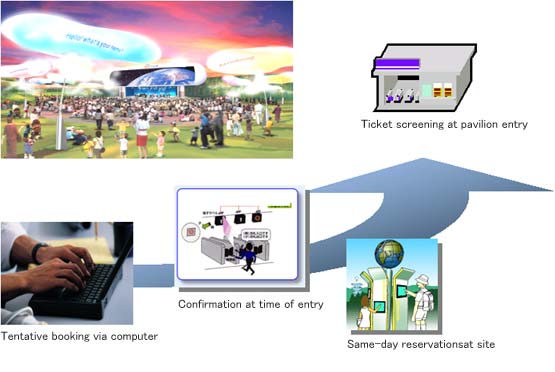
1. Access to Expo Site
Information about transportation to the Expo Site will be provided by various means, including guidebooks and pamphlets, as well as Web-based information accessed through PCs and mobile telephones. The information will also include forecasts of crowding at the site or on transportation systems. This will allow visitors to enhance their experience by avoiding these times.
All transportation-related information, including information about public transport operations, traffic conditions on roads in the area around the site, the number of free spaces in the Expo site parking lots, and the operations of the Linear Motor Car and shuttle bus services, will be collected and integrated within the Intelligent Transport Systems (ITS). The systems will supply this information to visitors in real time through mobile telephones, Internet, car navigation systems, FM radio stations, and other channels (*1).
2. Distribution of Expo Information
A NEO Platform capable of supporting multiple devices will be developed to distribute information about EXPO 2005. This system will edit and organize all Expo-related information for distribution in forms that will be readily understood by all users. And because the system will be configured for third-generation use, it will create a world in which all users will have easy access to information that will be easy to use.
An Editing Center for all Expo-related information will be established. During the Expo period, this facility will gather a variety of information through systems and interviews. After editing and compiling into forms that can be readily understood, this information will be distributed efficiently through a wide range of devices, including Internet, video display panels, mobile telephones, and FM radios.
Several methods will be used to disseminate information. Approximately 50 public display panels (PDPs) will be installed in the site to provide visitors with timely access to various information, including details of nearby pavilions, event notices, and guidance about crowding and transportation. Near the site Gates there will be congestion display panels (*2) to provide visitors with real-time information about the level of crowding in each Zone. Near the entrance to each Zone there will be display panels(*3) with information about waiting times to enter each pavilion. Information about events, congestion and transportation will also be accessible via Internet using computers or Web-capable mobile telephones.
Video Display System

50 Inch Plasma Display
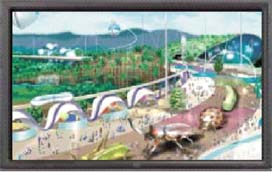
(The scene shown is as an indication only. Actual display images will differ.)
Pavilion Waiting Time System
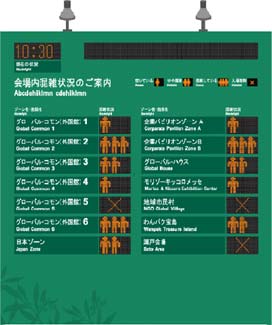
Crowding Display Panel

Pavilion Waiting Time Display Panel
3. Facilitating Pavilion Visits
Waiting in line for long periods has been seen as an inevitable part of the visitor's experience at past Expos, such as Expo '70 in Osaka. Yet the imposition of this major inconvenience on those who have taken the trouble to visit Expo contradicts the concept of a visitor-focused Expo.
At EXPO 2005, it will be possible to check and obtain information about pavilions and event schedules in advance via Internet or Web-capable mobile telephones (*4). For the first time at a major Expo, admission tickets will contain mu-chips to facilitate access to the site (*5), and it will be possible to use these tickets to make advance reservations for admission to major pavilions and other facilities (*6).
Visitors will also be able to use their mu-chip tickets to make reservations on the day of their visit. Those with reservations will be able to enter even the most popular pavilions without waiting in long lines, simply by displaying the tickets on which their reservations are recorded.
Admission Reservation System
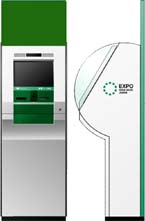
Same-day Reservation Terminal
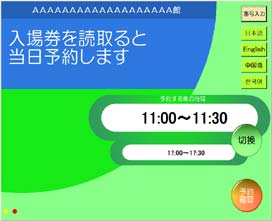
Same-Day Reservation Screen
4. Design Your Own EXPO 2005 Experience
A host of corporate and official pavilions and a wide spectrum of events await visitors to EXPO 2005. Yet the experience of an Expo tour could be even better if visitors were able to obtain information in advance that would allow them to know the route to the site on the day of their visit, and to select their preferred pavilions.
Visitors to EXPO 2005 will be able to use their home computers to plan their access route to the site, check pavilions and events, and choose the pavilions and activities that most interest them. This service will allow visitors to create their own Expo tours. It will also be linked to the pavilion reservation system, and visitors will be able to study transportation information and congestion forecasts as they plan their Expo visits (*7). In addition, visitors will be able to check their plans via Web-capable mobile telephones, and on the day of their visit they will be able to compare their plans with current information about transportation and pavilions.
5. Network Infrastructure for Services
The basic network infrastructure for these services will be a 1000-core optical fiber cable encircling the Global Loop. A LAN system and IP telephone system linked to this cable will ensure that information needed for site operations will flow smoothly. There will also be a system to provide overall management of essential operational information. This will be linked to the Editing Center system, creating a structure that will support information sharing among management staffs and the integrated provision of information to visitors.
A variety of measures will be implemented to protect these networks effectively from terrorist attacks or illegal access and jamming by cyber-terrorists.
6. Other Information
To monitor visitor numbers at the Seto Area, a system will be installed to count visitors automatically as they arrive and leave. The aim of this system is to minimize the environmental impact of excessive visitor numbers. In addition, admission of site management staffs and vehicles will be controlled by means of admission tickets bearing two-dimensional bar codes (QR codes).
*1: The Intelligent Transport Systems (ITS) will provide real-time access to various information, including space in parking lots and the operations of the shuttle bus and Linear Motor Car systems. This information will be shown on display panels at the Expo site and in terminal stations and other locations. It will also be available on the Association's official website.
*2: Congestion information will be displayed for each Zone. Four panels will be installed near each site Gate. The information will also be shown in 50 display panels within the site.
*3:These will show waiting times at pavilions and other facilities. A total of 13 will be installed at the site. The same information will also be displayed on 50 video display panels that will installed in the site.
*4:This information will also be updated continuously on the official website of the Japan Association for the 2005 World Exposition.
*5:The admission ticket system will instantly determine whether or not the bearer of a ticket is eligible to enter the site. It will also monitor visitor numbers.
*6:
- It will also be possible to make reservations via a home computer using the visit reservation system on the Association's official website.
- Pavilion reservations will be accepted from 9 a.m. on the same date in the month before the date of the intended visit, and up to midnight two days before the visit.
- Up to two advance reservations and one same-day reservation will be accepted. After the completion of a visit for which a same-day reservation was obtained, it will be possible to obtain another reservation.
- Advance reservations will be available for approximately 20% of capacity, so it will also be possible to enter pavilions without reservations.
- The Association believes that this is the first time that advance reservations are available for a large-scale event in Japan.
*7:Prospective visitors will be able to create their own plans on their computers using the Association's official website. Since this system will be linked to the visit reservation system, it will also be possible to make pavilion reservations. In addition, visitors will be able to link into the system and check their plans through Web-capable mobile telephones. The system will also provide visitors with easy access to information updates relating to their plans on the day of their visit.


